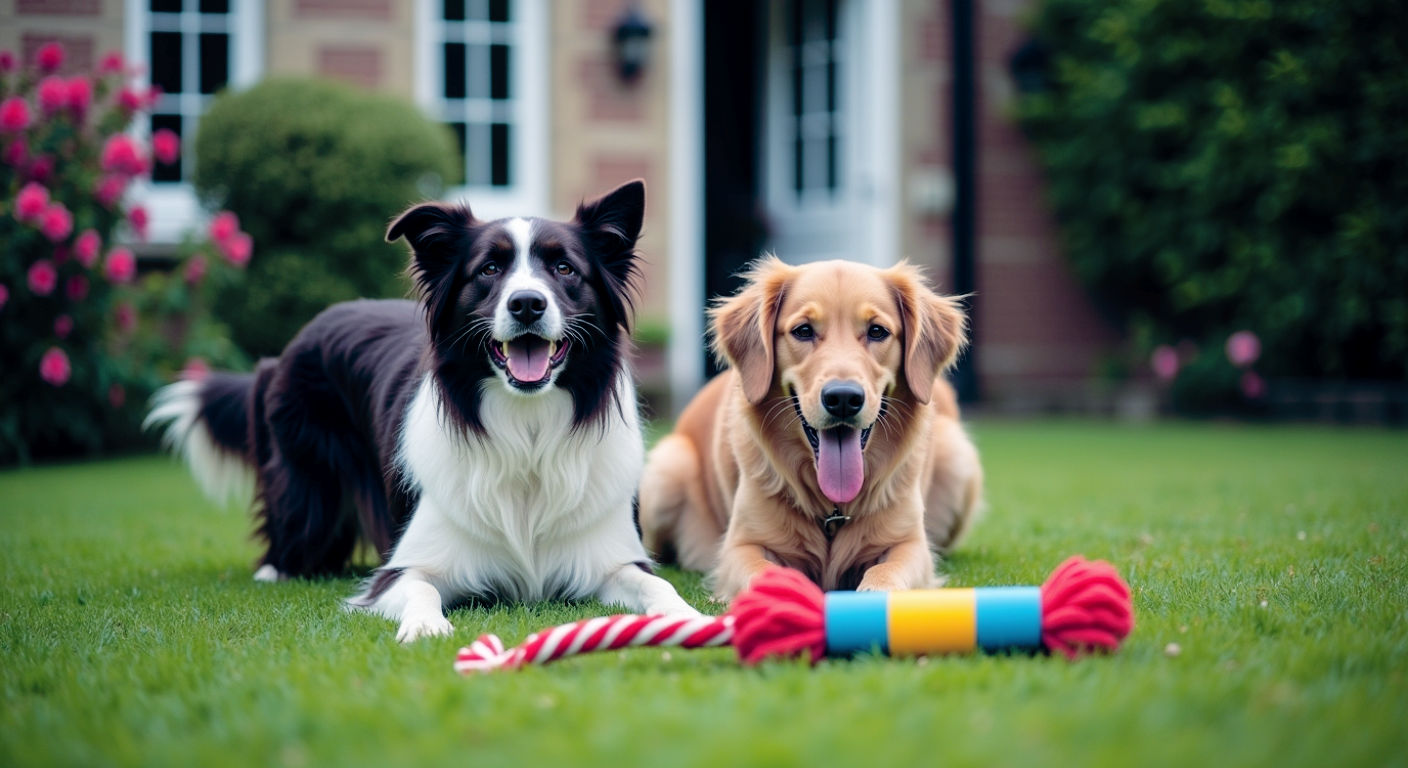The Guide to Dog Toys: Keeping Your Pup Happy, Healthy, and Out of Trouble
Our complete guide to the best dog toys for British pups. Learn how to choose safe, durable toys that prevent boredom, aid training, and improve dental health.

This post may contain affiliate links. If you make a purchase through these links, we may earn a commission at no additional cost to you.
Ever come home to find your favourite trainers looking like they’ve been through a woodchipper? Or perhaps your sofa cushions have mysteriously exploded into a cloud of fluff? If that sounds familiar, you’re not alone. Our four-legged friends, bless them, have a natural instinct to chew, play, and explore the world with their mouths. Without a proper outlet, that instinct can lead to, well, chaos.
That’s where the humble dog toy comes in. It’s not just a colourful squeaky thing to keep them busy; it’s a vital tool for their health, happiness, and training. Think of it as a cross between a gym membership, a puzzle, and a cuddly friend for your pup. A good toy can stop them from chewing your furniture, ease anxiety when you pop to the shops, keep their minds sharp, and help you build an incredible bond.
But walk into any pet shop, and the choice is overwhelming. Rows upon rows of balls, ropes, squeakers, and strange rubber contraptions. How on earth do you know what’s right for your dog? A tiny Chihuahua has very different needs from a bouncy Labrador, and a gentle old Greyhound won’t play the same way as a clever Border Collie.
That’s what this guide is for. We’re going to break down everything you need to know to become a dog toy expert. We’ll explore the different types of toys, what makes them safe (or unsafe), and how to pick the perfect ones for your dog’s specific breed, age, and personality. Consider this your complete manual for turning playtime into a powerful tool for a happier, healthier, and better-behaved companion.
Why Do Dogs Even Need Toys? It’s Not Just About Fun
It’s easy to think of dog toys as a bit of a luxury, but they’re as essential as a good lead or a comfy bed. A dog’s brain is wired for certain behaviours that go all the way back to their wolf ancestors: chasing, catching, and chewing. In our modern homes, they don’t get to do much of that. Without a proper way to act on these instincts, they can get bored, stressed, and even destructive.
Think of it like this: a bored teenager with nothing to do might start causing mischief. A bored dog is exactly the same, but their idea of mischief involves your prize-winning roses or the telly remote.
Here’s a closer look at why toys are so important:
Mental Stimulation: Beating the Boredom Brain
Dogs are incredibly intelligent. Breeds like Border Collies, Poodles, and German Shepherds were bred to solve complex problems all day long. Even if your dog’s main job is napping on the sofa, their brain still craves a challenge.
- Puzzle toys, where they have to work out how to get a treat, are a fantastic way to engage their minds. It’s like a Sudoku puzzle for your pup. This mental workout tires them out just as much as a long walk, which is brilliant for rainy British days when you can’t get out. A mentally tired dog is a calm and happy dog.
Physical Exercise: More Than Just Walkies
A daily walk is brilliant, but it doesn’t always satisfy a dog’s full range of physical needs.
- Fetch toys like balls and frisbees encourage sprinting and chasing, which is great for their heart and muscles.
- Tug toys allow them to use their strength in a controlled way, building muscle in their neck and shoulders. It’s a fantastic bonding game, as long as you teach them the ‘drop it’ rule!
This kind of play mimics the hunting behaviours of their ancestors, providing a satisfying physical release that a simple walk around the park can’t match.
Dental Health: A Toothbrush They’ll Actually Enjoy
Chewing is a natural doggy behaviour, but it also serves a vital purpose: keeping their teeth clean.
- Dental chew toys are designed with special textures, ridges, and nubs that scrape away plaque and tartar as your dog chews. This helps to prevent gum disease and keep their breath a bit fresher.
- For puppies, chewing on a firm but forgiving toy can soothe the discomfort of teething. It gives them something appropriate to gnaw on instead of your fingers or the legs of the kitchen table.
Preventing Destructive Behaviour: Save Your Sofa!
As we’ve mentioned, a dog without a proper outlet for its energy will find its own. This is the number one reason people’s belongings get destroyed.
By providing a range of interesting and durable toys, you teach your dog what they are allowed to chew. It channels their natural instincts into a positive activity. The key is to make the toys more interesting than your shoes. This means rotating them regularly to keep them novel and playing with your dog to make the toys seem extra special.
Easing Anxiety and Providing Comfort
Dogs are social animals. They can get anxious when left alone, a condition often called separation anxiety.
- A comfort toy, like a soft plush teddy, can act as a familiar friend when you’re not there. The scent of their home (and you) on the toy can be incredibly reassuring.
- A puzzle toy filled with their favourite treats can also be a brilliant distraction. It gives them a rewarding job to focus on when you leave, helping to build a positive association with being on their own.
In short, toys are not a treat. They are a fundamental part of your dog’s well-being, crucial for their mental, physical, and emotional health.
The Big Seven: A Breakdown of Dog Toy Types
Once you understand why your dog needs toys, the next step is figuring out which ones to get. The sheer variety can be baffling, but most toys fall into one of seven main categories. A good “toy box” for your pup should have something from a few of these different groups to keep things interesting.
1. Chew Toys: For the Power Gnawer
These are the workhorses of the toy world. Designed for serious, prolonged chewing, they are typically made from tough materials like nylon, dense rubber, or natural products.
- What they’re for: Satisfying the primal urge to chew, cleaning teeth, and providing a long-lasting distraction. They’re perfect for dogs who can destroy a lesser toy in minutes.
- Examples: Nylabone DuraChew, KONG Extreme, Benebone Wishbone. Natural options include antlers, olive wood chews, and buffalo horns.
- Best for: Strong-jawed breeds like Staffordshire Bull Terriers, Rottweilers, and German Shepherds. Also fantastic for teething puppies (choose a softer puppy-specific version).
- Watch out for: Make sure they are the right size. A toy that’s too small can be a choking hazard. For natural chews like antlers, supervise your dog to ensure they don’t splinter or chew off a piece that’s too big to swallow.
2. Puzzle and Interactive Toys: For the Brainy Pup
These toys are all about making your dog think. They require problem-solving skills to release a treat or a piece of kibble hidden inside.
- What they’re for: Busting boredom, slowing down fast eaters, and providing mental stimulation. They are a lifesaver on wet days when you can’t get out for a long walk.
- Examples: KONG Classic (when stuffed with food), Nina Ottosson puzzle boards, treat-dispensing balls.
- Best for: Intelligent, high-energy breeds like Border Collies, Spaniels, and Poodles. They’re also great for any dog that gets bored easily or suffers from mild separation anxiety.
- Watch out for: Start with an easy puzzle and work your way up. If it’s too difficult, your dog might get frustrated and give up (or just chew the toy to pieces to get the food out).
3. Fetch Toys: For the Dog Who Loves to Run
This category is for the classic game of fetch. These toys are designed to be thrown and retrieved.
- What they’re for: High-intensity physical exercise, satisfying the instinct to chase, and strengthening your bond.
- Examples: Tennis balls (though be careful, the fuzz can be abrasive on teeth), rubber balls like the Chuckit! Ultra Ball, frisbees designed for dogs.
- Best for: Retrievers, naturally! Labradors, Golden Retrievers, and Spaniels often live for a game of fetch. Also great for any dog with a lot of energy to burn.
- Watch out for: Make sure the ball is large enough that it can’t be accidentally swallowed or get lodged in their throat. Avoid standard tennis balls for powerful chewers, as they can be easily ripped apart and ingested.
4. Tug Toys: For a Healthy Game of War
Tug-of-war is a brilliant game for dogs, despite old myths that it causes aggression. When played correctly, it’s a fantastic way to burn energy and practise commands like “drop it”.
- What they’re for: Strength-building exercise, impulse control training, and interactive play with you.
- Examples: Rope toys, rubber rings with handles, and fleece tugs.
- Best for: Dogs who love to pull and play interactively. Terriers and Bull breeds often adore a good game of tug.
- Watch out for: Always let your dog win sometimes to keep their confidence up. Never play with a dog that guards its toys, and always teach a solid “drop it” or “give” command. Stop the game if their teeth accidentally touch your skin. Inspect rope toys regularly for loose threads that could be swallowed.
5. Plush and Cuddle Toys: For the Softer Side
These are the soft, squeaky, cuddly toys that many dogs love to carry around, snuggle with, or gleefully disembowel.
- What they’re for: Providing comfort, satisfying the “prey” instinct (shaking and “killing” the squeaker), and gentle indoor play.
- Examples: Squeaky teddy bears, soft animals with minimal stuffing, comfort blankets.
- Best for: Gentle players and dogs that like to “nurture” their toys. Many Greyhounds and Whippets love a soft toy to cuddle. Also good for puppies.
- Watch out for: These are not for aggressive chewers. A strong dog can rip one apart in seconds, and swallowing the stuffing or squeaker can be extremely dangerous, potentially causing a fatal blockage. Always supervise your dog with plush toys.
6. Dental Health Toys: For a Sparkling Smile
While many chew toys offer dental benefits, this category is specifically designed to clean teeth and massage gums.
- What they’re for: Reducing plaque and tartar build-up and promoting good oral hygiene.
- Examples: Toys with lots of textures, nubs, and grooves. Brands like Petstages and KONG have specific dental lines. You can often add dog-friendly toothpaste to the grooves for extra cleaning power.
- Best for: All dogs, but particularly breeds prone to dental issues like Dachshunds, Yorkshire Terriers, and Pugs.
- Watch out for: These are not a replacement for professional vet checks or, if your dog allows it, brushing. They are a helpful tool in your dog’s overall dental care routine.
7. Floating Toys: For the Water Babies
If your dog loves a good swim, these toys are a must-have for summer trips to the beach or a local dog-friendly lake.
- What they’re for: Fun and exercise in the water.
- Examples: KONG Aqua, Chuckit! Amphibious range, floating rubber rings and balls. They are usually made of lightweight foam, rubber, or nylon and are brightly coloured to be easily seen in the water.
- Best for: Water-loving breeds like Labradors, Golden Retrievers, Poodles, and Spaniels.
- Watch out for: Always supervise your dog around water. Ensure the toy is durable enough that they won’t chew bits off and swallow them while swimming.
Choosing the Right Toy: A Three-Point Checklist for Your Dog
Now you know the types of toys available, how do you pick the perfect one for your dog? It’s not about what looks cutest to you; it’s about what best suits their individual needs. Consider these three factors: Breed and Size, Age, and Chewing Style.
1. Breed and Size: A Toy for Every Type
A dog’s breed gives you huge clues about their instincts and what kind of play they’ll enjoy. Their size, meanwhile, dictates how safe a toy is.
- The Rule of Thumb for Size: A toy should be large enough that it can’t be swallowed whole, but small enough for your dog to carry comfortably. If you’re unsure, always size up. A toy that’s too big is less of a risk than one that’s too small and could become a choking hazard.
Let’s look at some popular British breeds and their toy preferences:
- Labradors and Golden Retrievers: These guys were born to fetch. Durable balls, frisbees, and floating toys for swimming are perfect. They are also often powerful chewers, so tough rubber toys like the KONG Extreme are a great choice to keep them occupied.
- Jack Russell Terriers: Tenacious and clever, JRTs love a challenge. Tug toys let them use their strength, while puzzle toys will keep their sharp minds busy. They often love “killing” squeaky plush toys, but they need close supervision to make sure they don’t eat the evidence!
- Cocker and Springer Spaniels: These energetic dogs thrive on interactive play. They excel at fetch and love scent work. A ball launcher can help you keep up with their stamina, and hiding treats in a snuffle mat (a fabric mat with lots of folds) engages their amazing noses.
- Staffordshire Bull Terriers: Staffies are known for their incredibly powerful jaws. They need the toughest of the tough. Super-durable chew toys made from solid nylon or the black KONG range are essential. They also love a good game of tug, which is a great way to bond.
- Border Collies: Arguably the cleverest breed, Collies need a job to do. Complex puzzle toys, treat-dispensing balls, and learning tricks with toys will keep their brains from getting bored and destructive. They also love to herd, so a large, durable ball they can push around the garden can be a big hit.
- Pugs and French Bulldogs (Brachycephalic Breeds): These flat-faced breeds can have trouble picking up certain shapes. Look for toys that are easy to grab, like ring shapes, toys with handles, or oddly-shaped rubber toys. Because of their breathing issues, avoid overly intense exercise. Gentle tug and puzzle toys are ideal.
2. Age: From Teething Pup to Golden Oldie
A dog’s needs change dramatically throughout their life.
- Puppies (8 weeks – 6 months): This is all about teething. Their adult teeth are coming in, and their gums are sore. They need toys that are soft enough to give but firm enough to soothe. Look for puppy-specific rubber toys (like the puppy KONG), rope toys, and plush toys (under supervision!). Avoid hard toys that could damage their developing teeth.
- Adolescents (6 months – 2 years): This is peak energy and often peak naughtiness! They have their strong adult teeth and a desperate need to burn off energy. This is the time for durable chew toys, interactive fetch toys, and lots of engaging puzzle toys to keep their brains occupied.
- Adults (2 years – 7 years): By now, you should have a good idea of your dog’s personality. The goal is to maintain a healthy routine with a good rotation of their favourite types of toys, whether that’s fetch, tug, or chewing.
- Seniors (7+ years): Older dogs might be slowing down, but they still need to play. Their jaws might not be as strong, and their eyesight could be failing. Opt for softer rubber toys, gentle plush toys for comfort, and easier puzzle toys to keep their minds active. Brightly coloured toys can be easier for them to see.
3. Chewing Style: The Gentle Nibbler vs. The Destroyer
This is perhaps the most important factor for safety. You need to be honest about your dog’s ability to destroy things.
- The Gentle Nibbler/Licker: These dogs are easy on their toys. They might mouth them gently, lick them, or just carry them around like a prize. They can usually be trusted with plush toys and softer latex toys.
- The Average Chewer: This is most dogs. They’ll chew and play with their toys but don’t make it their life’s mission to annihilate them. They’ll be happy with a good range of toys, from ropes and fetch balls to standard rubber chew toys. They should still be supervised with plush toys.
- The Power Chewer/Destroyer: These dogs are the champions of destruction. A plush toy lasts seconds, a tennis ball is confetti in a minute. For these dogs, safety is paramount. You must invest in ultra-durable toys. Look for words like “extreme,” “indestructible,” or “power chewer” on the packaging. Brands like KONG (the black range), Nylabone, and GoughNuts specialise in toys for these demolition experts. Even with these, no toy is truly indestructible, so always check them for damage.
By considering these three points, you can move from randomly guessing in the pet shop to making an informed choice that will keep your dog safe, happy, and entertained.
The Dog Toy Safety MOT: What to Look For and What to Avoid
A broken toy isn’t just a waste of money; it can be a serious health hazard. A piece of swallowed plastic, rubber, or fabric can cause a life-threatening internal blockage, leading to an emergency trip to the vet and expensive surgery.
Think of it as a safety check, like an MOT for your dog’s toys. Here’s your checklist to ensure playtime stays safe.
Red Flags: Toys and Materials to Avoid
- Toys That Are Too Small: This is the biggest risk. Any toy that can fit entirely inside your dog’s mouth is a choking hazard. It can get lodged at the back of their throat and block their airway. Always buy toys appropriate for your dog’s size, not the size of the dog you wish you had.
- Cooked Bones: Never, ever give a dog a cooked bone. Cooking makes them brittle, and they can splinter into sharp shards that can pierce your dog’s mouth, throat, or intestines. This is a veterinary emergency waiting to happen.
- Rawhide: This is a controversial one. While many dogs love it, rawhide is treated with chemicals and can pose two risks. Firstly, as it gets chewed, it can break off into chunks that, when swallowed, can swell in the stomach and cause a blockage. Secondly, some rawhide from overseas has been found to be contaminated. If you do choose to give it, supervise closely and choose a high-quality product from a reputable source. Many vets in the UK now advise against it.
- Cheap, Brittle Plastic Toys: Low-quality plastic can shatter into sharp pieces when chewed, which can cut your dog’s mouth and gums or be swallowed.
- Toys with Small, Glued-On Parts: Avoid toys with things like plastic eyes, buttons, or ribbons that can be easily chewed off and swallowed.
- Children’s Toys: These are not designed to withstand a dog’s jaws and often contain small parts or stuffing (like beads) that are dangerous if ingested. Stick to toys made specifically for dogs.
Green Flags: What Makes a Toy Safe?
- Durable, Dog-Safe Materials: Look for high-quality, non-toxic rubber, durable nylon, or 100% natural cotton for rope toys. Reputable brands invest heavily in creating materials that are safe and tough.
- The Right Size and Shape: As mentioned, it must be too big to be swallowed. Consider the shape, too. A toy with a single hole (like a ring) is generally safer than one with two, as a dog’s lower jaw can sometimes get stuck in the latter.
- Easy to Clean: Toys can get covered in slobber and dirt, becoming a breeding ground for bacteria. Toys made of rubber or nylon are brilliant because you can easily wash them in the sink or even pop them in the dishwasher.
- Made by a Reputable Brand: Brands like KONG, Nylabone, Chuckit!, and Planet Dog have a long history of making safe, durable toys and are trusted by vets and dog owners worldwide. While they might cost a bit more, they are a far better investment than a cheap toy that could endanger your dog.
Your Role: The Supervising Lifeguard
Even the safest toy in the world can become dangerous if it’s damaged. Your job is to be the lifeguard of the toy box.
- Inspect Toys Regularly: Before and after each play session, give the toys a quick check. Look for cracks, splinters, loose threads, or pieces that are about to break off.
- Throw Away Damaged Toys: Don’t be sentimental. If a toy is broken, it’s no longer safe. Bin it immediately. Yes, even if it’s their absolute favourite. Their safety is more important.
- Supervise, Supervise, Supervise: This is especially crucial when you introduce a new toy. You don’t know how your dog will interact with it until you watch them. Pay close attention to see if they are trying to rip it apart and swallow the pieces.
- Know Your Dog: Ultimately, you are the expert on your dog. If you know you have a destroyer on your hands, don’t take risks with soft or easily broken toys, no matter how cute they are.
By following these simple rules, you can ensure that playtime is a source of joy, not a source of worry.
Making Playtime Powerful: Tips and Tricks for a Better Bond
Having the right toys is only half the battle. How you use them can make a huge difference to your dog’s behaviour and your relationship with them. Play is one of the best ways to build trust, teach commands, and reinforce your status as the fun-giver-in-chief.
The Art of Toy Rotation: Keep Things Fresh
Have you ever noticed how your dog goes absolutely bonkers for a new toy, but after a few days, it’s left in the corner, forgotten? Dogs, like us, get bored of the same old thing.
This is where toy rotation comes in. Don’t leave all their toys out all the time. Instead, keep a stash of them hidden away. Every few days, swap the toys they have out for some “new” ones from the cupboard.
- Why it works: The toys that have been hidden away will seem brand new and exciting again. This prevents toy boredom and saves you a fortune, as you don’t need to constantly buy new things to hold their interest. It also makes the toys a higher-value reward.
Play With Your Dog: You Are the Best Toy
A toy sitting on the floor is boring. A toy that you are playing with is the most exciting thing in the world.
- Interactive play is key: Make time every day to actively play with your dog. A 10-15 minute game of tug or fetch can do more to strengthen your bond than an hour of them chewing a toy alone.
- Use toys in training: Toys can be a powerful reward for training, especially for dogs who aren’t very motivated by food. Ask for a “sit” before you throw the ball. Use a game of tug as a reward for a good recall. This makes training fun and exciting.
How to “Teach” Your Dog to Play
Some dogs, especially rescues, might not know how to play with toys. They may never have had them before. You might need to show them how.
- Get excited: Your energy is contagious. Talk in a happy, high-pitched voice and act like the toy is the best thing ever.
- Make it move: Drag a rope toy along the floor to engage their prey drive. Roll a ball gently towards them.
- Keep it positive: Don’t force the toy on them. Praise and reward them with a treat for any interaction, even if they just sniff it at first.
- Keep sessions short and sweet: Start with just a minute or two of play and end on a high note, while they are still engaged. This will leave them wanting more.
The “Drop It” Command: The Golden Rule of Play
This is one of the most important commands you can teach your dog, and it’s essential for safe play. It means you can end a game at any time and get a potentially dangerous object off them.
- The Two-Toy Method: Start a game of tug. While they are pulling on one toy, introduce a second, equally exciting toy. As you wiggle the new toy, say “drop it” in a clear, upbeat voice. Most dogs will drop the first toy to grab the new one. When they do, praise them enthusiastically and start playing with the new toy.
- The Treat Swap: If the two-toy method doesn’t work, use a high-value treat. While they have the toy, hold a tasty treat near their nose and say “drop it”. When they drop the toy to take the treat, praise them.
- Practice, practice, practice: Practice this regularly when the stakes are low, so that they will respond instantly if they ever pick up something they shouldn’t.
By making playtime a structured, interactive, and fun part of your daily routine, you can turn a simple toy into a powerful tool for building a wonderful relationship with your best friend.
Conclusion: The Right Toy is More Than Just a Toy
Choosing a dog toy isn’t just about grabbing the first squeaky thing you see. It’s about understanding your dog’s deepest instincts—their need to chew, to chase, to solve problems, and to connect with you. A well-chosen toy is a gateway to better behaviour, improved health, and a stronger, happier bond between you and your pup.
By thinking about your dog’s breed, age, and individual chewing style, you can build a collection of toys that doesn’t just keep them busy, but truly enriches their life. Remember the safety MOT: check toys regularly and throw them away when they become worn or damaged. And most importantly, remember that you are your dog’s favourite playmate. Make time to get down on the floor and join in the fun.
The perfect toy can help channel the energy of a boisterous young pup, soothe the teething pains of a new arrival, keep the mind of a clever Collie sharp, and provide comfort to an anxious soul. It’s an investment in your dog’s well-being and in the peace and quiet of your own home. So go on, open up that toy box and unlock a world of happy, healthy play. Your dog (and your furniture) will thank you for it.
Further Reading
For more expert advice on dog health, behaviour, and welfare, please visit these highly respected British organisations:
- The RSPCA (Royal Society for the Prevention of Cruelty to Animals): https://www.rspca.org.uk/adviceandwelfare/pets/dogs
- The Kennel Club: https://www.thekennelclub.org.uk/health-and-dog-care/
- Blue Cross: https://www.bluecross.org.uk/advice/dog
- Dogs Trust: https://www.dogstrust.org.uk/help-advice/






